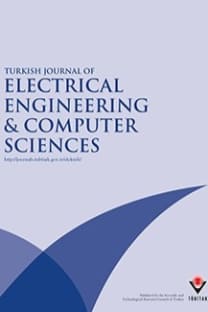A new heuristic method to solve unit commitment by using a time-variant acceleration coefficients particle swarm optimization algorithm
Economic load dispatch, time-variant acceleration coefficients particle swarm optimization algorithm, unit commitment
A new heuristic method to solve unit commitment by using a time-variant acceleration coefficients particle swarm optimization algorithm
Economic load dispatch, time-variant acceleration coefficients particle swarm optimization algorithm, unit commitment,
___
- [1] H.Y. Yamin, “Review on methods of generation scheduling in electric power systems,” Electric Power System Research, Vol. 69, pp. 227–248, 2004.
- [2] H.W. Kuhn, A.W. Tucker, “Nonlinear programming,” in Proceedings of the Second Berkeley Symposium on Mathematical Programming Statistics and Probability, Berkeley, CA, USA, University of California Press, 1951.
- [3] C.K. Pang, G.B. Sheble, F. Albuyeh, “Evaluation of dynamic programming based methods and multiple area representation for thermal unit commitments,” IEEE Transactions On Power Systems, Vol. 100, pp. 1212–1218, 1981.
- [4] A.M. Geoffrion, “Lagrangian relaxation for integer programming problems,” Mathematical Programming Study, Vol. 2, pp. 82–114, 1974.
- [5] S.A. Kazarlis, A.G. Bakirtzis, V. Petridis, “A genetic algorithm solution to the unit commitment problem,” IEEE Transactions on Power Systems, Vol. 11, pp. 83–92, 1996.
- [6] I.G. Damousis, A.G. Bakirtzis, P.S. Dokopoulos, “A solution to the unit commitment problem using integer-coded genetic algorithm,” IEEE Transactions on Power Systems, Vol. 19, pp. 1165–1172, 2004.
- [7] J. Ebrahimi, S.H. Hosseinian, G.B. Gharehpetian, “Unit commitment problem solution using shuffled frog leaping algorithm,” IEEE Transactions on Power Systems, Vol. 26, pp. 573–581, 2011.
- [8] X. Yuan, H. Nie, A. Su, L. Wanga, Y. Yuan, “An improved binary particle swarm optimization for unit commitment problem,” Expert Systems with Applications, Vol. 36, pp. 8049–8055, 2009.
- [9] X. Yuan, H. Nie, A. Su, L. Wanga, Y. Yuan, “Application of enhanced discrete differential evolution approach to unit commitment problem,” Energy Conversion and Management, Vol. 50, pp. 2449–2456, 2009.
- [10] Y.W. Jeong, J.B. Park, S.H. Jang, K.Y. Lee, “A new quantum-inspired binary PSO: application to unit commitment problems for power systems,” IEEE Transactions on Power Systems, Vol. 25, pp. 1486–1495, 2010.
- [11] K.A. Juste, H. Kita, E. Tanaka, J. Hasegawa, “An evolutionary programming solution to the unit commitment problem,” IEEE Transactions on Power Systems, Vol. 14, pp. 1452–1459, 1999.
- [12] N.D. Simopoulos, D.S. Kavatza, D. Vournas, “Unit commitment by an enhanced simulated annealing algorithm,” IEEE Transactions on Power Systems, Vol. 21, pp. 68–76, 2006.
- [13] M. Eslamian, S.H. Hosseinian, B. Vahidi, “Bacterial foraging based solution to the unit-commitment problem,” IEEE Transactions on Power Systems, Vol. 24, pp. 1478–1488, 2009.
- [14] M.M. Hadji, B. Vahidi, “A solution to the unit commitment problem using imperialistic competition algorithm,” IEEE Transactions on Power Systems, Vol. 27, pp. 117–124, 2012.
- [15] B. Pavez-Lazo, J. Soto-Cartes, “A deterministic annular crossover genetic algorithm optimisation for the unit commitment problem,” Expert Systems with Applications, Vol. 38, pp. 6523–6529, 2011.
- [16] S. Najafi, Y. Pourjamal, “A new heuristic algorithm for unit commitment problem,” Energy Procedia, Vol. 14, pp. 2005–2011, 2012.
- [17] C.C. Su, Y.Y. Hsu, “Fuzzy dynamic programming: an application to unit commitment,” IEEE Transactions on Power Systems, Vol. 6, pp. 1231–1237, 1991.
- [18] K.A. Juste, H. Kita, E. Tanaka, J. Hasegawa, “An evolutionary programming solution to the unit commitment problem,” IEEE Transactions on Power Systems, Vol. 14, pp. 1452–1459, 1999.
- [19] C. Wang, S.M. Shahidehpour, “Effects of ramp rate limits on unit commitment and economic dispatch,” IEEE Transactions on Power Systems, Vol. 8, pp. 1341–1350, 1993.
- [20] J. Kennedy, R.C. Eberhart, “Particle swarm optimization,” in Proceedings of IEEE International Conference on Neural Networks (ICNN’95), Perth, Australia, Vol. 4, pp. 1942–1948, 1995.
- [21] K.T. Chaturvedi, M. Pandit, L. Srivastava, “Particle swarm optimization with time varying acceleration coefficients for non-convex economic power dispatch,” International Journal of Electrical Power Energy Systems, Vol. 31, pp. 249–257, 2009.
- [22] A.J. Wood, B.F. Wollenberg, Power Generation Operation and Control, New York, Wiley, 1984.
- ISSN: 1300-0632
- Yayın Aralığı: Yılda 6 Sayı
- Yayıncı: TÜBİTAK
Efficient ID-based authentication and key agreement protocols for the session initiation protocol
Hacı Hakan KILINÇ, Yolguly ALLABERDİYEV, Tuğrul YANIK
Mohammad Jakirul ISLAM, Ahmed Wasif REZA, Kamarul Ariffin NOORDIN
Arsalan NAJAFI, Mohsen FARSHAD, Hamid FALAGHI
Bandwidth extension of narrowband speech in log spectra domain using neural network
Sara POURMOHAMMADI, Mansour VALI, Mohsen GHADYANI
Epilepsy diagnosis using artificial neural network learned by PSO
Nesibe YALÇIN, Gülay TEZEL, Cihan KARAKUZU
A new feature selection model based on ID3 and bees algorithm for intrusion detection system
Adel Sabry EESA, Zeynep ORMAN, Adnan Mohsin Abdulazeez BRIFCANI
Continuous-time Hopfield neural network-based optimized solution to 2-channel allocation problem
